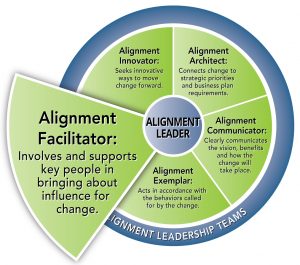An Alignment Facilitator finds creative ways to reach consensus, align organizational choices and develop others in alignment thinking. They also make trade-offs that will help the organization bring about change.
Specifically, an Alignment Facilitator:
- Recognizes and brings together key individuals with the right capabilities to successfully evaluate design options and enact change
- Creates cross-functional teams to assist with agreeing on a shared vision, designing the organization, and facilitating change
- Identifies and involves those with positional or social influence to support and remove barriers for the change to happen
Read More about Becoming a Better Alignment Facilitator
Research shows that how teams think together most determines how they will perform together. Read how team members' roles and thinking styles can influence their participation and engagement.
 Better Utilize Change Agents in Your Change Transformation
Better Utilize Change Agents in Your Change Transformation
To successfully navigate through a change transformation, businesses need key people to help push the change forward and integrate the new concepts into the organization.
Examples of Leaders Who Demonstrate the Alignment Facilitator Competency
Vice President of IT Transformation at a global Services & Manufacturing Company
When the organization's new Chief Information Officer requested a review of the IT function and its capabilities prior to initiating a transformation effort, the leader of IT Transformation understood the political and organizational complexities of the task. Not only would she need to ensure alignment across the various IT departments but also across the organization's business units and corporate functions. Despite the time and expense, she insisted that a high-involvement approach be used. Many in the organization, including the CIO, challenged her assumption that getting key leaders and stakeholders in a room to evaluate the organization was the right course of action, but she held firm. She organized an initial planning session with the leadership team to define the scope and activities necessary to define the strategic intent and design principles that would shape their alignment decisions. As the leadership team came to a consensus on their strategy, direction and design principles, she found a partner that shared her vision of collaborative, high-involvement work. Together they facilitated numerous design sessions with the leadership team and other members of the IT organization to assess the capabilities of the IT function and propose changes to how it operated. The organization transformation journey lasted a couple of years, but this leader gained credibility over time because the level of acceptance for the changes was high and the design choices were well aligned with the leadership team's strategy and design principles. Interestingly, this leader gained a reputation in the company overall as being a change agent and other functions and business units sought her advice on how they could set up their transformation efforts successfully.
Plant Manager for Design and Start-up of New, State-of-the-Art Manufacturing Facility at global Automotive Company
This dynamic executive was introduced to the organization design process during a multi-day working session wherein she and her leadership team focused on redesigning the North America purchasing organization. A few years later, when tasked with opening a brand new factory for the company's newest luxury product, she led her team through a similar high-involvement design process that focused on aligning organization choices and making clear trade-off decisions about what this one-of-a-kind plant would be able to produce. Throughout the build-out, she led a cross-functional design and implementation team that continually reviewed and made adjustments to the design. This team maintained responsibility for all aspects of the factory build-out and start-up by identifying areas of potential misalignment and constantly making adjustments to ensure optimal alignment of work processes, structure and roles, metrics, skills, staff and talent, and culture.
Former CEO of Fortune 50 Industrial Company
Beyond a laser focus on efficiency and profits, Jack Welch believed that customer satisfaction and positive relationships with employees were deciding factors that determined the success of a business. Thus, Welch made efforts to cultivate relationships with suppliers, customers, and employees. He understood that his employees' actions had a direct impact on productivity so he communicated with workers often so they would feel that at any moment they could receive a note or visit from “the boss.” Welch would often send handwritten notes to anyone in the company who he felt deserved personal recognition and feedback - whether to motivate, correct, or congratulate. Welch also personally reviewed everyone who worked directly for him. These performance reviews not only gave specific and ongoing feedback to employees but also provided a chance for Welch to dive deep into areas of business that each employee was leading. His efforts bringing together customer, supplier and employees, engaging with workers, and being hands-on in the business performance of his direct team, helped him facilitate alignment in action and thinking. Many who worked with him felt a sense of pride because they were part of something significant. GE employees, under the direction of Welch would successfully enact change because Welch fostered a culture “that if a task was important enough for Welch to care about, it was important enough to perform [or create] with the utmost effort."
CFO of the European Region and Interim Regional General Manager of a Global Oil & Energy Company
Knowing he would only hold his regional position for six months, this CFO didn’t just keep the business on auto pilot, he initiated an aggressive change program to help the business turnaround. With his team, they worked on identifying the profitability of the different product lines. He then brought all the leaders in the organization together, and initiated a process to design the organization around the parts of the business that showed the greatest opportunity for growth and profitability. Even with his highly appointed position and opinionated views on what needed to be done, he understood the importance of involving all the team members. By disregarding his own ability and involving the team members, this great change was fully implemented because everyone had a part and followed the rationale for the changes.
